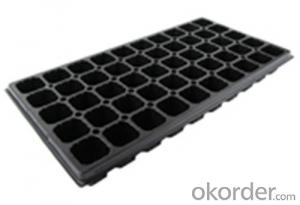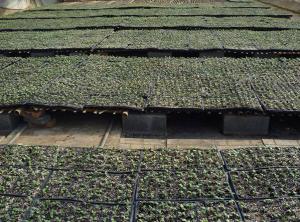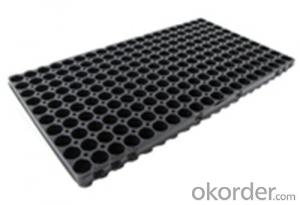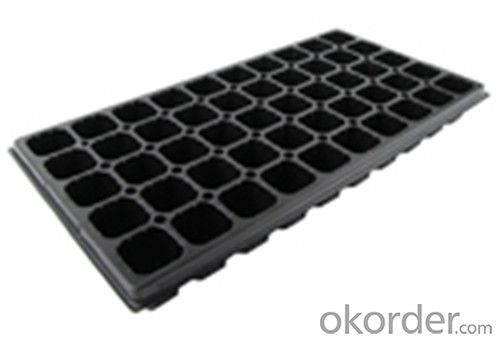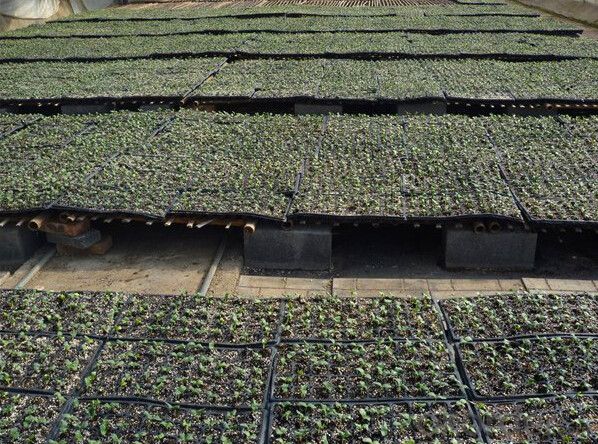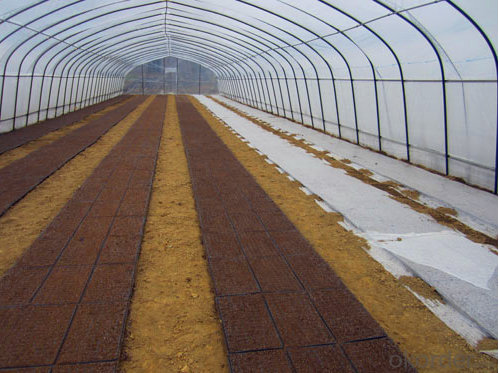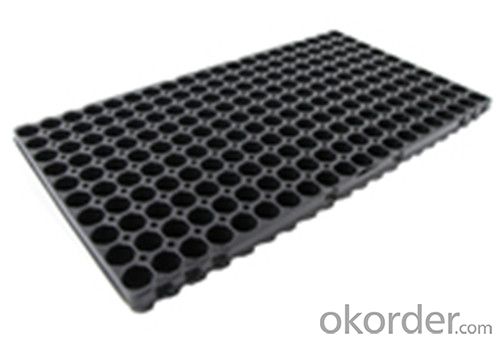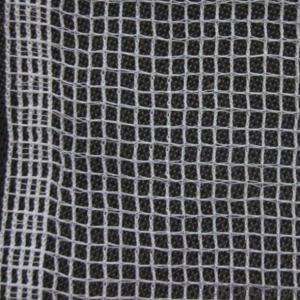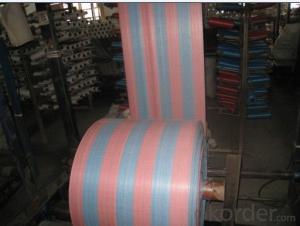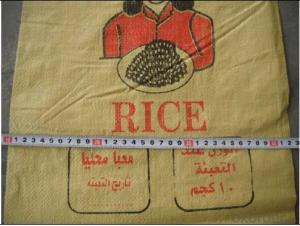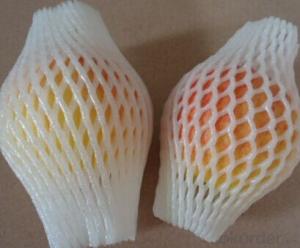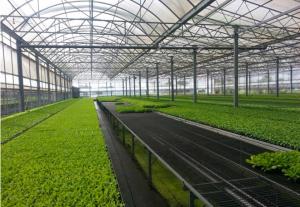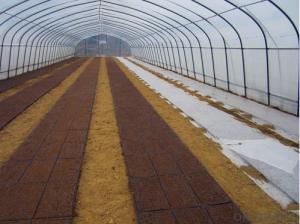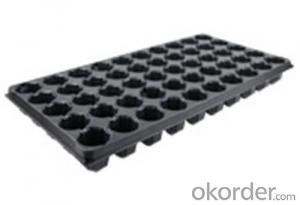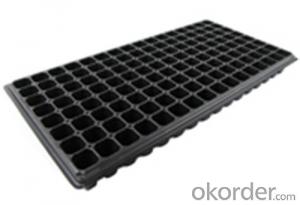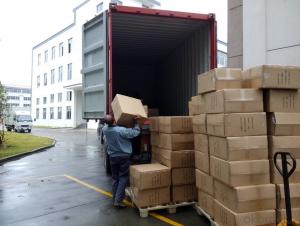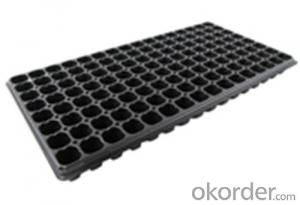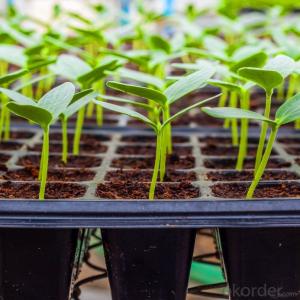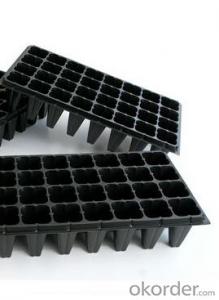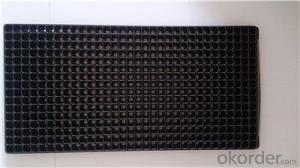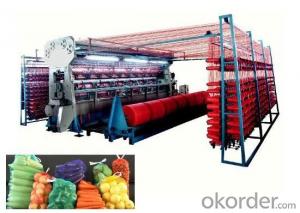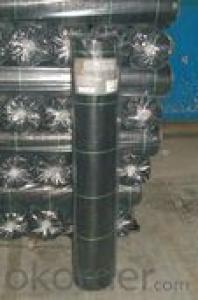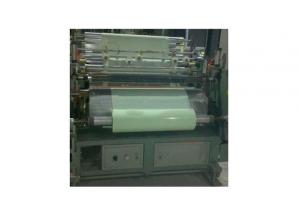Nursery Seeding Tray HIPS Seed Tray Plastic Tray
- Loading Port:
- China main port
- Payment Terms:
- TT or LC
- Min Order Qty:
- 1000 pc
- Supply Capability:
- 10000000 pc/month
OKorder Service Pledge
OKorder Financial Service
You Might Also Like
Structure of the seed tray:
· Top quality and competitive price.
· Variety design and good appearance.
· Easy to use, and remove.
· Durable and reusable.
· Eco-Friendly.
Description Main Features of the seed tray:
· Ideal for Starting seeds and Transplanting Seedling.
· Suitable for both manual and automatic planting.
· Suitable for Propagating Vegetables, Flowers and other plant from seed in green-house or indoors.
Thickness vs. Weight
· Thickness of trays are from 0.5mm to 1.0mm.
· 1.0mm: 155g±5g; 100pcs/ctn.
· 0.9mm: 140g±5g; 120pcs/ctn.
· 0.7mm: 110g±5g; 150pcs/ctn.
· 0.6mm: 95g±5g; 180pcs/ctn.
· 0.5mm: 80g±5g; 200pcs/ctn.
·
Using time:
· thickness of 0.5mm can be used 1 to 2 times.
· thickness of 0.6mm can be used 3 to 4 times.
· thickness of 0.7mm can be used 5 to 6 times.
· thickness of 0.8mm can be used 7 to 8 times.
· thickness of 0.9mm can be used 8 to 9 times.
· thickness of 1.0mm can be used 8 to 10 times.
Seed Tray Specification:
Material | ps/pvc |
Thickness | 0.5mm-1.5mm, standard:1mm |
Weight | 80g(±5)g-230g(±5)g, Standard weight:155g(±5)g |
Size | length:490mm-540mm, width:190mm-345mm,depth:25mm-150mm Standard:54mmX28mm |
Cell count | 18-512 |
Package | in carton |
Using time | 8-10 times |
FAQ:
Q:How Can I Get A Sample?
A:You can get samples by communicate with our export sales.
Q:How Long Is Delivery?
A:Delivery time will be 7-25 days according to order quantity.
Q:What Is The MOQ?
A:Our MOQ is 1*20FT container quantity, allow to mix several items.
Q:What Is Our Normal Payments Terms?
A:Our normal payment terms now is T/T, L/C or Western Union,Papal.
Q:How Do I Order Your Products?
A:You can check our website for any items you interest and you can also get communication with our export sales and order for it accordingly.
Q:What Kinds Of Material We Use In Our Product?
A:Our plastic flower pots use material such as PP polymer or PE polymer.
- Q: who has the best fishing plastic baits I want to try different kinds. Ive only mostly used zoom, I was wondering if berkley or mann's or any other brands work good too
- black and red flake tube texas rig, little tip put some alcacelcer are what ever you call it, but put a little bit in the tube all the way up inside the tube works well like that in murky water try it it might as well be against the law but it aint
- Q: Can nursery trays be used for growing microgreens?
- Yes, nursery trays can be used for growing microgreens. They provide a convenient and affordable option for starting and growing microgreens as they allow for easy planting, watering, and harvesting. Nursery trays with drainage holes are particularly suitable as they help prevent waterlogging and promote healthy root development.
- Q: What are some ground cover options for hot climates?
- Some ground cover options for hot climates include succulents such as sedum or ice plants, drought-tolerant grasses like buffalo grass or zoysia grass, and heat-resistant perennial plants like lantana or gazania.
- Q: Are there any ground cover plants that are suitable for wet or boggy areas?
- Yes, there are several ground cover plants that thrive in wet or boggy areas. Some popular options include creeping Jenny, marsh marigold, lizard's tail, and sweet flag. These plants have adapted to waterlogged conditions and provide excellent coverage while adding beauty to such areas.
- Q: Can I throw my CDs to plastic recycling trash?
- I okorder , craig's list, or some similar site. Depending upon how many you have, you might also want to check in with a local school to see if one of the teachers would like some for an in-class project and/or a group like Cub/Boy Scouts, Girl Scouts, Campfire, etc...
- Q: How is cornstarch used to make biodegradable plastics LOL
- Cornstarch..okorder / 1. Place a tablespoon of cornstarch in a plastic Ziploc bag. 2. Add two drops of corn oil to the cornstarch. 3. Add one tablespoon of water to the oil and cornstarch. 4. Mix the cornstarch, corn oil, and water in the plastic bag by rubbing the outside of the bag with your fingers. 5. Add two drops of your favorite food coloring and mix again. 6. Place the bag in a microwave oven on high for 20-25 seconds. DO NOT completely seal the bag. CAREFUL, it’s hot!
- Q: Are agricultural plastic products safe for groundwater?
- Agricultural plastic products, when used and disposed of properly, are generally considered safe for groundwater. However, improper handling, disposal, or excessive use of agricultural plastics can pose a risk to groundwater quality. It is crucial to follow best management practices, such as proper storage, recycling, and disposal methods, to prevent any potential contamination of groundwater resources.
- Q: Are there any ground cover plants that are suitable for coastal salt spray?
- Yes, there are several ground cover plants that are suitable for coastal salt spray. Some examples include beach grass (Ammophila breviligulata), sea thrift (Armeria maritima), beach morning glory (Ipomoea pes-caprae), and seaside goldenrod (Solidago sempervirens). These plants have adapted to tolerate the harsh conditions of coastal areas, including salt spray and high winds.
- Q: Are nursery trays suitable for ground cover plants?
- Yes, nursery trays are suitable for ground cover plants. The trays provide a controlled and convenient environment for starting and growing ground cover plants before they are transplanted into the ground. They allow for easy handling, watering, and transplanting, making them a practical choice for cultivating ground cover plants.
- Q: This question asks about the impact of agricultural plastic products on the well-being of animals.
- <p>Agricultural plastic products, such as plastic mulch films and nets, can significantly affect animal welfare. These products, when not properly managed, can lead to entanglement or ingestion by animals, causing injury or death. Entanglement in plastic nets can restrict movement, leading to stress and physical harm. Ingestion of plastic can cause blockages in the digestive system, malnutrition, and even starvation. Additionally, the decomposition of plastic releases harmful chemicals into the soil and water, which can affect the health of animals and their food sources. Therefore, it's crucial to manage agricultural plastics responsibly to minimize their negative impact on animal welfare.</p>
Send your message to us
Nursery Seeding Tray HIPS Seed Tray Plastic Tray
- Loading Port:
- China main port
- Payment Terms:
- TT or LC
- Min Order Qty:
- 1000 pc
- Supply Capability:
- 10000000 pc/month
OKorder Service Pledge
OKorder Financial Service
Similar products
Hot products
Hot Searches
Related keywords
